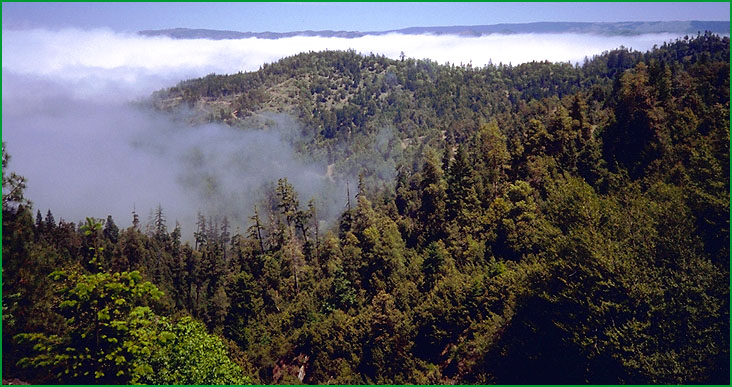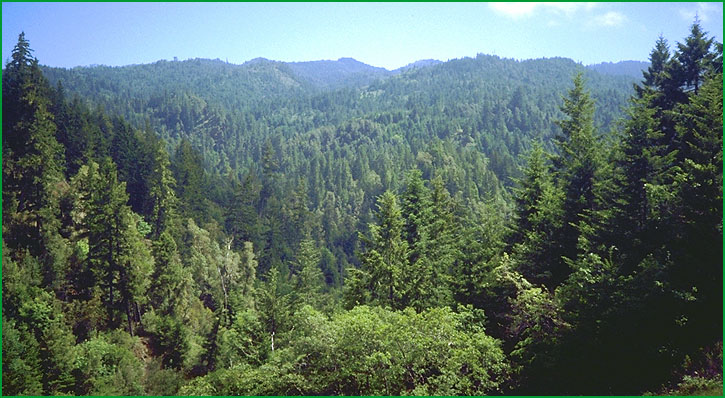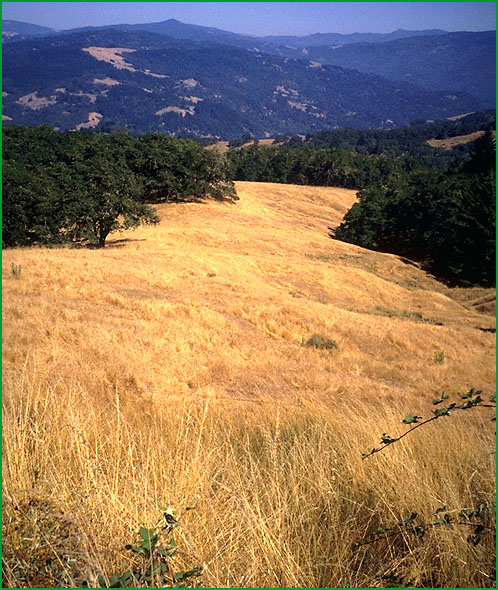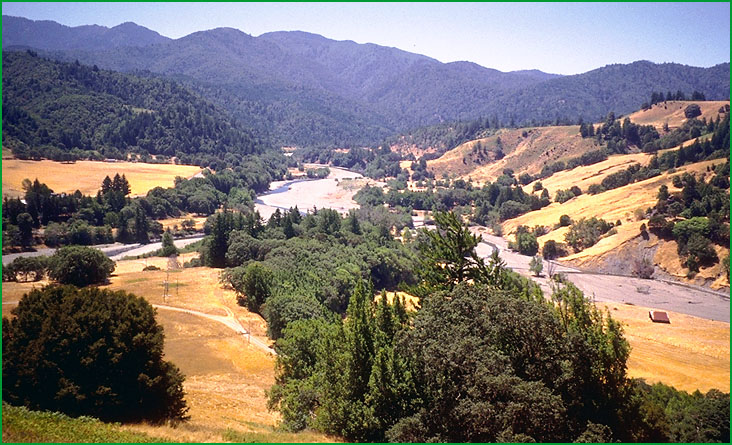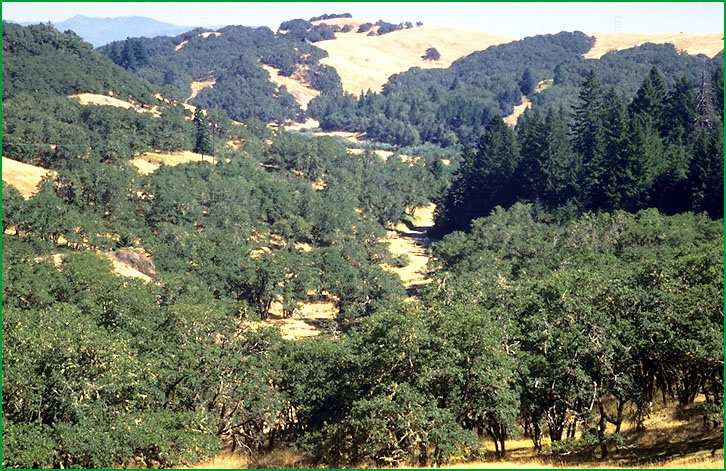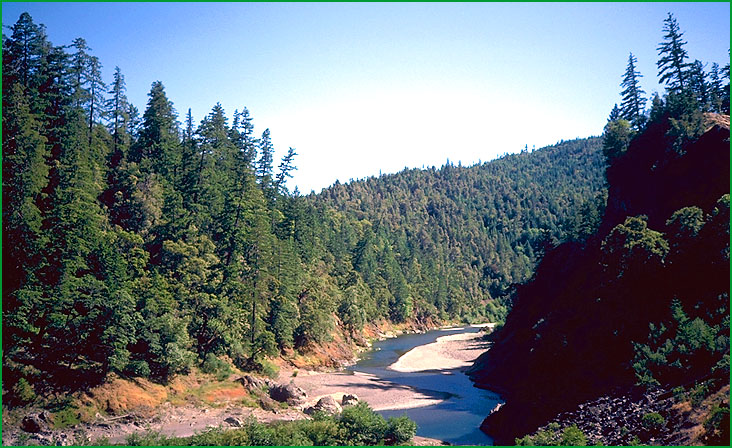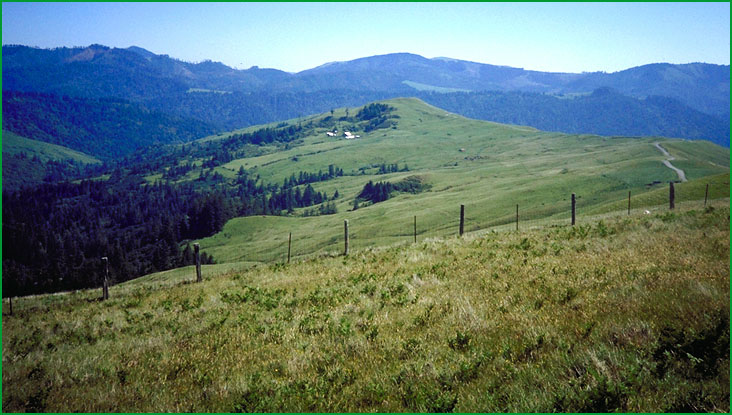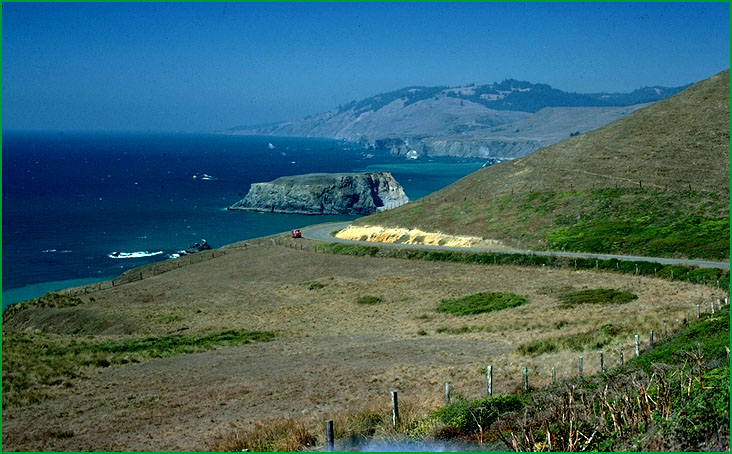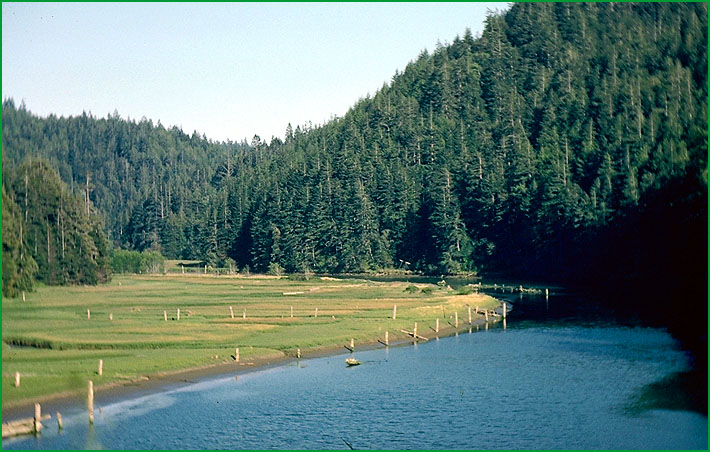 | Central Franciscan - Coastal Franciscan-Fort Bragg Terraces |
Central Franciscan -Larabee Buttes area and coastal fog Ś David Howell |
Central Franciscan-Douglas-fir and Tanoak Ś David Howell |
Central Franciscan-Oregon white oak and grass hills near Alderpoint Ś David Howell |
Coastal Franciscan-King Range from Honeydew area Ś David Howell |
Coastal Franciscan- Howdy Goudey |
Coastal Franciscan- oak and Douglas-fir glade lands in Humboldt County Ś David Howell |
Coastal Franciscan- Redwoods in the South Fork Eel River Ś David Howell |
Coastal Franciscan- coastal prairie, Bear River ridge Ś David Howell |
Fort Bragg Terraces -Coastal terraces near Navarro River Ś Robert Ettner |
Fort Bragg Terraces -Big River Ś James R. Nelson |
http://www.fs.fed.us/r5/projects/ecoregions/263af.htm
Subsection 263Af
Central Franciscan
This subsection is a steep mountainous area of the northern California Coast Ranges, south-southeast of Patricks Point. Most of it is between the Bald Mountain fault on the east-northeast and the Fresh Water fault on the west-southwest. The climate is temperate and humid. There is substantial oceanic influence on climate, including summer fog in the northern part of the subsection. MLRAs 4b and 5b.
Lithology and Stratigraphy. This subsection is dominated by Jurassic and Cretaceous Franciscan sedimentary, minor volcanic, and metamorphic rocks of the Central Belt; some Franciscan rocks of the Coastal Belt are present. They are intensely folded and faulted. There are small areas of Tertiary marine sedimentary rocks and ultramafic rocks are sparsely scattered through the Franciscan Complex.
Geomorphology. This is a subsection of mountains with rounded ridges, steep and moderately steep sides, and narrow canyons. Most of the mountains are elongated in north-northwest to northwest directions and have subequal summits with increasing elevation toward the interior. Larabee Valley along the Van Duzen River is wide enough to have an appreciable alluvial plain. The subsection elevation range is from sea-level up to 4408 feet on Showers Mountain. Mass wasting and fluvial erosion are the main geomorphic processes.
Soils. The soils are mostly Typic Humitropepts and Mollic Hapudalfs in the northern one-third of the subsection. They are predominantly Dystric Xerochrepts and Haploxeralfs in the southern two-thirds of the subsection, and less extensive Ultic Argixerolls. The soils are leached free of carbonates, with the possible exception of some Argixerolls, and the older ones in the northern part of the subsection are strongly acid. The soil temperature regimes are predominantly isomesic in the northern one-third and mesic in the southern two-thirds of the subsection. Soils in grassland in the southern part of the subsection have thermic soil temperature regimes. Soil moisture regimes are predominantly udic and xeric (near udic).
Vegetation. The predominant natural plant communities are Redwood series in the northern one-third and Douglas-fir - tanoak series in the southern two-thirds of the subsection. Needlegrass grasslands are common in the southern part of the subsection, and Oregon white oak series is also common. Common in riparian areas are Red alder series in the northern part and Black cottonwood series in the southern part of the subsection.
Characteristic series by lifeform include:
Grasslands: Introduced perennial grassland series, Purple needlegrass series.
Shrublands: Coyote brush series, Salal - California huckleberry series.
Forests and woodlands: Black cottonwood series, Black oak series, California bay series, Douglas-fir - tanoak series, Grand fir series, Oregon white oak series, Redwood series, Sitka spruce series, Tanoak series, Western hemlock series.
Climate. The mean annual precipitation is about 40 to 80 inches. Most is rain at lower elevations and some is snow at higher elevations. Mean annual temperature is about 40░ to 53░ F. The mean freeze-free period is about 225 to 300 days.
Surface Water. Runoff is rapid and many of the smaller streams are dry by the end of the summer. Natural lakes are absent.
Subsection 263Ag
Coastal Franciscan
This subsection is a steep mountainous area of the northern California Coast Ranges, near the coast, south from Humboldt Bay to the Russian River. There is substantial oceanic influence on climate, including summer fog. MLRA 4b.
Lithology and Stratigraphy. This subsection is dominated by Cretaceous, Jurassic, and early Tertiary Franciscan marine sedimentary rocks of mostly the Coastal Belt, but includes some of the Central and Eastern Belts. There are relatively small areas of upper Pliocene marine sediments at the north and south ends of the subsection and Tertiary marine sediments in and around the Kings Range. Ultramafic rocks are scattered through the Franciscan Complex.
Geomorphology. This is a subsection of mountains with rounded ridges, steep and moderately steep sides, and narrow canyons. Most of the mountains are elongated in north-northwest to northwest directions and have subequal summits. There are small areas of Quaternary alluvium along the Van Duzen, Eel, Navarro, and Russian Rivers. The subsection elevation range is from sea-level up to 4088 feet at Kings Peak. Mass wasting and fluvial erosion are the main geomorphic processes.
Soils. The soils are mostly Ultic and Mollic Hapudalfs in the northern part, Ultic Haplustalfs in the southern part, and Ultic and Typic Haploxeralfs in the central and southern interior parts of the subsection. They are predominantly Typic Tropohumults and Ultic Hapludalfs on Tertiary marine sediments east of the King Range. The soils are leached free of carbonates, and some older soils are strongly acid. The soil temperature regimes are predominantly isomesic, but are mesic in the central and southern interior parts of the subsection. Soil moisture regimes are predominantly udic in the northern part, ustic in the southern part, and xeric (nearly udic or ustic) in the central interior part of the subsection.
Vegetation. The predominant natural plant communities are Redwood series, Douglas-fir - tanoak series, and Needlegrass grasslands in the King Range, and Douglas-fir - tanoak series in the central and southern interior parts of the subsection. Canyon live oak series is common on very steep slopes. Sergeant cypress series is common on serpentinitic soils. Black cottonwood series is common in riparian areas.
Characteristic series by lifeform include:
Grasslands: California annual grassland series, European beachgrass series, Foothill needlegrass series, Introduced perennial grassland series, Purple needlegrass series.
Shrublands: Coyote brush series.
Forests and woodlands: Black cottonwood series, Black oak series, Blue oak series, California bay series, Canyon live oak series, Coast live oak series, Douglas-fir - tanoak series, Grand fir series, Interior live oak series, Oregon white oak series, Ponderosa pine series, Redwood series, Sergeant cypress series, Sitka spruce series, Tanoak series, Valley oak series.
Climate. The mean annual precipitation is about 40 to 110 inches. Most is rain at lower elevations and some is snow at higher elevations. Mean annual temperature is about 40░ to 53░ F. The mean freeze-free period is about 225 to 300 days.
Surface Water. Runoff is rapid and many of the smaller streams are dry by the end of the summer. Natural lakes are absent.
Subsection 263Ah
Fort Bragg Terraces
This subsection is on an elevated coastal plain that is between mountains of the northern California Coast Ranges and the Pacific Ocean. It has a temperate and humid climate, with much summer fog. MLRA 4b.
Lithology and Stratigraphy. This subsection contains predominantly clastic Pleistocene marine deposits and Franciscan marine sedimentary rocks of the Coastal Belt.
Geomorphology. This subsection is on an elevated coastal plain with several levels of terraces. The terraces are nearly level, but they are deeply dissected to expose Franciscan rocks in ravines. The uppermost terrace is about 800 feet above mean sea-level. Ocean currents, waves, and wind are active along the outer edges of the terraces. Fluvial erosion is the main geomorphic process on the terraces, although eolian erosion and deposition has been active in the past. Mass wasting is another process that is active on steep ravine slopes.
Soils. The soils on the terraces are mostly Typic and Plinthic Tropohumults and Dystropepts. Those in Franciscan rock terrain are mostly Ultic Hapudalfs. Less extensive, but notable for the ōpygmy forestö on them, are Albaqults and Duraquods. The soil temperature regimes are isomesic. Soil moisture regimes are mostly udic with some aquic.
Vegetation. The predominant plant community is Redwood series. Grand fir and western hemlock series also occur. Bishop pine series and Pygmy cypress series occur on Albaqults and Duraquods. Red alder series is common in riparian areas.
Characteristic series by lifeform include:
Dune vegetation: Native dunegrass series, European beachgrass series, Sand - verbena - beach bursage series.
Grasslands: Introduced perennial grassland series, Pacific reedgrass series.
Forests and woodlands: Beach pine series, Bishop pine series, Grand fir series, Pygmy cypress series, Red alder series, Redwood series, Western hemlock series.
Climate. The mean annual precipitation is about 40 to 50 inches; there is considerable summer fog. Mean annual temperature is about 50░ to 53░ F, and there is less than 14░ F difference between lowest and highest monthly means. The mean freeze-free period is about 300 days.
Surface Water. Water runs off of the terraces slowly and the broader terraces are poorly drained between ravines that drain the edges of the terraces more rapidly.
